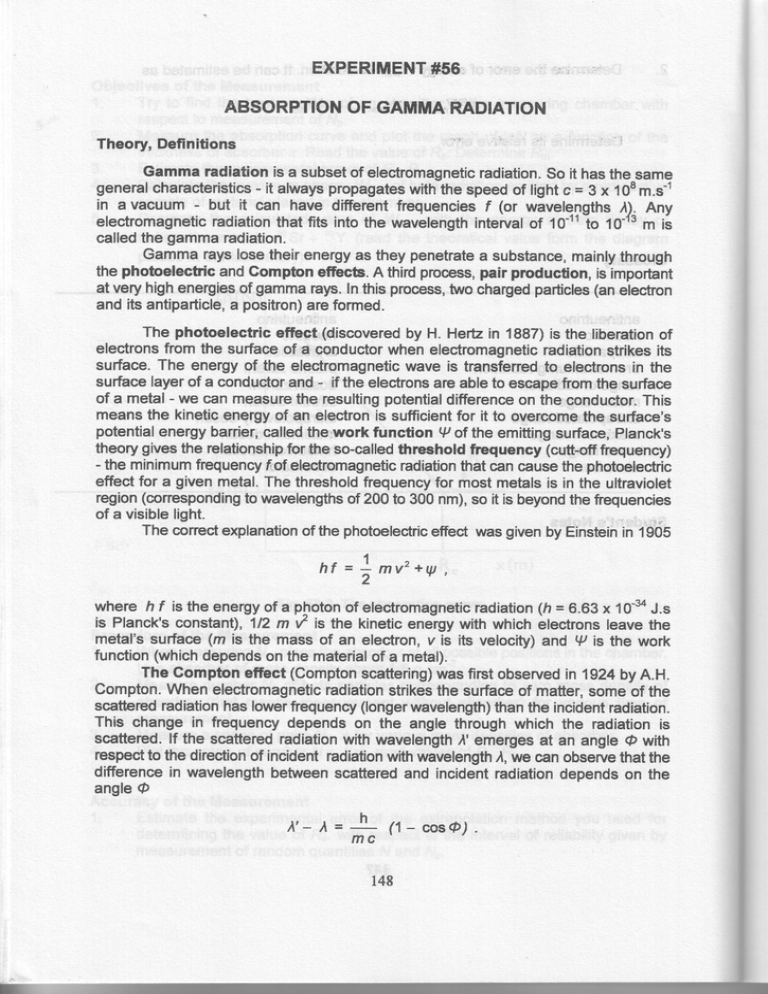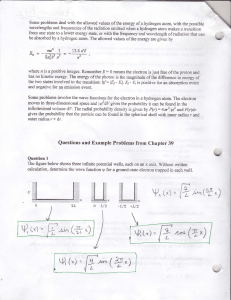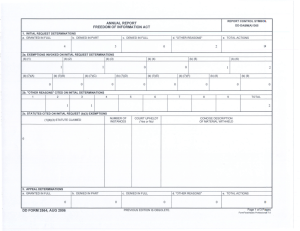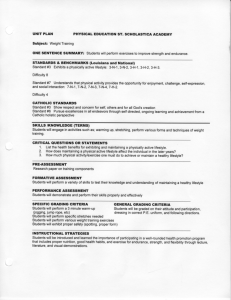EXPERIMENT #56,, :,, ,: ABSORPTION OF GAMMA RADIATION
advertisement

EXPERIMENT
#56,,
:,, ,:
ABSORPTION
OF GAMMARADIATION
!J
Theory,Definitions
Gammaradiationis a subsetof electromagnetic
radiation.So it hasthe same
- it alwayspropagates
generalcharacteristics
withthe speedof lightc = 3 x 108m.s-1
in a vacuum but it can have differentfrequenciesf (or wavelengths,,1).Any
electromagnetic
radiationthat fits into the wavelengthintervalof 10-11
to 10-13m is
calledthe gammaradiation.
Gammarayslosetheirenergyas they penetratea substance,mainlythrough
the photoelectricandGompbn effects.A thirdprocess,pair production,is important
at veryhighenergiesof gammarays.In thisprocess,
twochargedparticles(anelectron
and its antiparticle,
a positron)3re formed.
The photoelectriceffect,(discovered
by H. Hertzin 1887)is the liberationof
electronsfrom the surfaceof a conductorwhenelectromagnetic
radiationstrikesits
surface.The energyof the electromagnetic
wave is transferredto electronsin the
surfacelayerof a conductorand- if the electronsare ableto escapefromthe surface
of a metal- we can measurethe resultingpotentialdifferenceon the conductor.This
meansthe kineticenergyof an electronis sufficientfor it to overcomethe surface's
potentialenergybarrier,calledthe:workfunction tlr of the emittingsurface,Planck's
theorygivesthe relationship
forthe so-calledthreshold frequency(cutt-offfrequency)
- the minimumfrequencyf;ofelectromagnetic
radiationthat can causethe photoelectric
given
for
effect a
metal.The thresholdfrequencyfor mostmetalsis in the ultraviolet
region(corresponding
to wavelengths
of 200to 300nm),so it is beyondthe frequencies
of a visiblelight.
,...
The correctexplanation
of the photoelectric
effect wasgivenby Einsteinin 1905
1
h f = ^ v ' t"W
t
,
where h f is the energyof a photonof electromagnetic
radiation(h = 6.63x 10-eJ.s
is Pfanck'sconstant),112m f is the kineticenergywith whichelectronsleavethe
metal'ssurface(m is the mass of an electron,v is its velocity)and tP is the work
function(whichdependson the materialof a metal).
The Comptoneffect (Comptonscattering)
wasfirstobservedin 1924by A.H.
Compton.Whenelectromagnetic
radiationstrikesthe surfaceof matter,someof the
scatbredradiationhaslowerfrequency(longerwavelength)
thanthe incidentradiation.
This change in frequencydependson the angle throughwhich the radiationis
scattered.lf the scatteredradiationwith wavelengthrl' emergesat an angle @with
respectto the directionof incidentradiationwithwavelength
l, we can observethat the
differencein wavelengthbetweenscatteredand incidentradiationdependson the
angle@
A,_A=
h
" ( 1_ c o s @ ) .
mc
148
We imagethe scatteringprocessas a collisionof two particles- the incident
photon(movingwithvelocityc) and an electron(initiallyat rest).Duringthisprocess,the
incidentphotongivesup someof its energyand momentumto the electron.
Absorptionof gammaradiationcan be describedby an exponentiallaw.The law
can be easilyderived"inthe'followihgway: if'parallelbeamof N photonswith equal
eneryie penetratea'certainmateriali4 tfiex-direction,thenaftercoveringthe distance
dx the radiationbecomesweaker(lessenergetic)anddN photonsare absorbedby the
to dx and the initial
material.The decreasein the.numberof photonsis proportional
N
numberof photons
_dN = ;r N dx ,
(56.1)
wherep is an absorptioncoefficient.
Eq.(56.1)gives
fi/ = No e-P'
(56.2)
described
The absorptioncoefficientp dependson allthreeof the processes
above,which talie place in the absorptionof gamma radiation.That is why the
absorptioncoefficientcan be expressedas
p = lJ"+ lJp"* lJ, ,
,
(56.3)
to the lossof energydue to the
wherep. is the absorptioncoefficientcorresponding
to lhe lossof the energy
Comptoneffect,lrp"is the absorptioncoefficientcorresponding
effect,and prois the absorptioncoefficientcorresponding
causedby the pirbtoelectric
to the pairformation.
as
Eq. (56.2)can alsobe exPressed
tn4fs= ux ,
(56.41
N
whichmeansthat In I
to the thicknessof the material;in the In
'r proportional
N
by a linethroughthe origin(itsslopeis p).
versusd graphit is represented
No
N
The half-tlricknessdnof a materialis the thicknessthatdecreasesthe incident
radiationenergyby one half.lt can be expressedas
dttz =
TheSl units:
ln2
p
(56.5)
absorptioncoefficient [P] = m'1
half-thickness
[dru] = m
Objectivesof the Measurement
Besurethat
measuri$.flo'Ni'
ot,Eq.(56.3)bymeasurement
validity
1.
Gheckrthe
o-f each
error
relative
the
i,. ,1.,you arg able to secureconditionssuch that
149
measlrrement
of numberof photonsNiwillbe similarandwill neverexceed4%
2.
3.
AT
Plotthe graphof In {} = f(x).
N
Calculatethe absorption
coefficient
of a givenrnetalandcheckitsvaluewiththe
valueobtainedfrom the abovegrapha{ndwith the value^from
the graphin
Fig.56-1,56-2or 56-3,.Thesourceof gammaradiationis 60cowithe-neigy
of
I i '
1j73MeV.
Whenyou measurepp6,d^eJermine
the relationamongall threeprocessesin
ouCo
whichgammaradiation
of
losesits energy.
tl
(mn
1
0.3 0.40.5,,0.71.0
3
4 5
7
10
W (MeV)
Fig. 56-1.The absorpti<incoefficientof iron
as a function of the energyof gammaradiation
Gafculatethe half-thickness
duz .ata givenmaterialof an absorber.
Determine
the leastenergythata gammaradiation
photonmusthaveto forman
150
6.
electron4osirorrpair.|sthereanyconditionforthefrequency(wave|ength)of
the gamrnaradiation?
the enors of 1t,dtn'
irtii.t
{0
Wr$evl
cooper
co9m951t'of
Fig'55'2'Theabsorption
radiation
gamma
ii"i i"""tion of tnl Inergyof
, '.,
procedureof the Measurement,. . .,--^^^^r *rrarnarer
at the graph
l . W h e n m e a s u r i n g $ , c h g s g t h i c kpreciselyas
n e s s o f t hpossible'
ematerialinsuchawayth
errors
In No/N= ttii'"in be plottedas
t' in'sucha way t[at the relative
ilt"ry?lt
tid;
chose
Ni,
meaiuring
o/o'
When
Z.
::"''''"
and do not exceed4
time
of Ni ?re approximately-equal
longest
3.
4
the
= Mry.".ori"rpondingio
lvo
pnoton,
6t
t#'ffib"i
to alltime
Measure
witlirespect
N'
;nlo,'irom
the
Afi.Catculate ""ir".'k
interval
the
simirarto
achart
use
varues,
ilfiy'"B$tffi:lltf,::r,:?iJiiT#;,,red
one below:
151
I
ti
Xi
o,{wi)
Ati
_Nn
,' l n '
N''
00,1
125107050
0,20,5
';
' :
i
:i
\
( MeV)
.
Fig. 56-3.The absorptioncoefficientfor leadversusenergyof gammaradiation
TA... totalabsorption . PE ... photpelectriceffect
CE... Comptoneffect
,, PF... Fair.formation
.:,
4. lf thevariations
of fnNdN= f(x)canbeexpressed
asa linearfunction,
calculate
the
absorption
coefficient
of a givenmetalas
..
r52
I = n
l,
7=t
---i;;-
Ni
Ftn sq
, , --
,r
r
Lxi
i
-4
of lhe ileasurement
Accuracy
''The
t'otalsror of fte absorptioncoefficientp is the sum of systematicand
randomerors. tf fie graphof ln ,VdN= f(x) is reallya linearfunction(as the theory
predicts),ne can deducethatthe randomerrorof the measurement
is negligibleand
as
enor
can
dominate.
lt
be
estimated
can
that*4ssystematic
x (tt) = 1rt*"- tJ .
: ri-.:
too.
Determinethe relativeenor of yourmeasurement
',,
r.i :!1: : i.
'
' '
i
Glcsary
zflienigama
netickezhfeni
elektromag
fotoefekt
Comptnirvjev (rozptyl)
ufstupniprSce
prahovSfrekvence
absorp6nikoeficient
polotlou5fka"
tvorbap6rfi
153






